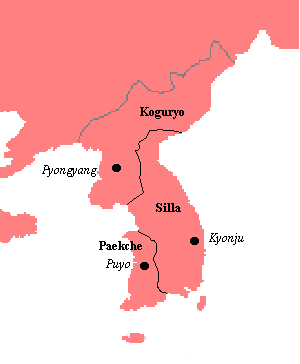Brief history of the ancient Korea

From early 4th century to the late 7th century,
there were three kingdoms, Koguryo, Silla and Paekche (Kudara) on the Korean peninsula.
(The word "Kudara" is Japanese language based upon old Korean language. Japanese call "Kudara"
for Paekche.)
Though there were small military and territorial conflicts among the three kingdoms
many times before mid-7th century, the conflicts became more and more larger to wars
including neighbouring China (Teng dynasty)
and Japan.
In 660, allied forces of Silla and China defeated allied forces of Paekche
and Japan and also defeated Koguryo in 668. Soon after the war in 668, the coalition of
Silla and China collapsed, because China intended to govern whole of the Korean peninsula.
Silla fought against China for 7 years and at last Chinese troops retreated.
Silla completed unification of the Korean peninsula in 676.
Relation between ancient Korea and Japan
Japan had diplomatic relation with the three kingdoms. The earliest establishment
of the diplomatic relation was with Paekche.
In 538, King Song of Paekche sent a mission to Japan bearing Buddhist images and sutras,
and this is taken as the beginning of Buddhism in Japan.
At the war between Silla (and China) and Paekche (and Japan) in 660, many people
emigrated to Japan from Paekche. Buddhists and craftsmen of the emigrants were
particularly welcome in Japan and they contributed to the progress of Buddhism
in ancient Japan.
